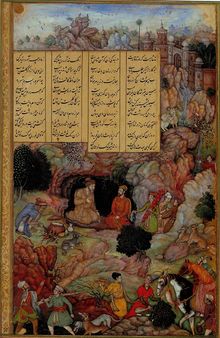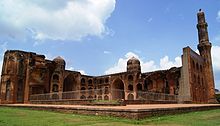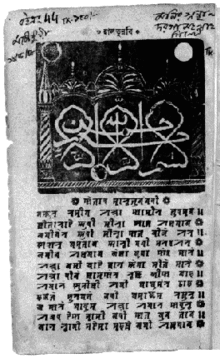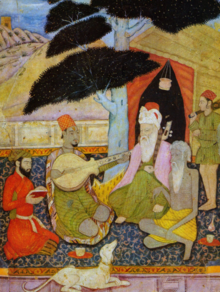Indo-Persian culture

Indo-Persian culturerefers to a cultural synthesis present on theIndian subcontinent.[1]It is characterised by theabsorption or integrationofPersian aspectsinto the various cultures of modern-day republics ofBangladesh,India,andPakistan.The earliest introduction of Persian influence and culture to the subcontinent was by variousMuslimTurko-Persianrulers, such as the 11th-centurySultan Mahmud Ghaznavi,rapidly pushed for the heavy Persianization of conquered territories innorthwestern Indian subcontinent,whereIslamicinfluence was also firmly established. This socio-cultural synthesis arose steadily through theDelhi Sultanatefrom the 13th to 16th centuries, and theMughal Empirefrom then onwards until the 19th century.[2]Various dynasties of Turkic, Iranian and local Indian origin patronized the Persian language and contributed to the development of a Persian culture in India.[3]The Delhi Sultanate developed their own cultural and political identity which built upon Persian and Indic languages, literature and arts, which formed the basis of an Indo-Muslim civilization.[4]
Persianwas the official language of mostMuslim dynastiesin the Indian subcontinent, such as theDelhi Sultanate,theBengal Sultanate,theMughal Empireand their successor states, and theSikh Empire.It was also the dominant cultured language of poetry and literature. Many of theSultansand nobility in the Sultanate period were Persianised Turks fromCentral Asiawho spokeTurkic languagesas theirmother tongues.The Mughals were also culturally Persianised Central Asians (ofTurko-Mongolorigin on their paternal side), but spokeChagatai Turkicas their first language at the beginning, before eventually adopting Persian. Persian became the preferred language of the Muslim elite of northern India.Muzaffar Alam,a noted scholar of Mughal and Indo-Persian history, suggests that Persian became the officiallingua francaof the Mughal Empire underAkbarfor various political and social factors due to its non-sectarian and fluid nature.[5]The influence of these languages led to avernacularcalledHindustanithat is the direct ancestor language of today'sHindi–Urduvarieties.
The Persianisation of the Indian subcontinent resulted in its incorporation into the cosmopolitan Persianate world ofAjam,known today academically asGreater Iran,which historically gave many inhabitants a secular, Persian identity.[6]
History
[edit]
With the presence ofIslamicculture in the region in theGhaznavid period,LahoreandUchwere established as centres ofPersian literature.Abu-al-Faraj RuniandMasud Sa'd Salman(d. 1121) were the two earliest major Persian poets based in Lahore. The earliest of the "great" Indo-Persian poets wasAmir Khusrow(d. 1325) ofDelhi,who has since attained iconic status within the Urdu speakers of the Indian subcontinent as, among other things, the "father" of Urdu literature.
Delhi sultanate and the Mughal era
[edit]Indo-Persian culture flourished in North India during the period of the Delhi Sultanate (1206–1526). The invasion of Babur in 1526, the end of the Delhi Sultanate and the establishment of what would become theMughal Empirewould usher thegolden ageof Indo-Persian culture with particular reference to the art and architecture of the Mughal era.
During the Mughal era,Persianpersisted as the language of the Mughals up to and including the year 1707 which marked the death of theEmperor Aurangzeb,generally considered the last of the "Great Mughals". Thereafter, with the decline of the Mughal empire, the 1739 invasion of Delhi byNader Shahand the gradual growth initially of theHindu Marathas[7]and later theEuropeanpower within the Indian subcontinent, Persian or Persian culture commenced a period of decline although it nevertheless enjoyed patronage and may even have flourished within the many regional empires or kingdoms of the Indian subcontinent including that of the Sikh MaharajaRanjit Singh(r. 1799–1837).
Persian as a language of governance and education was abolished in 1839 by theBritish East India Companyand the last Mughal emperorBahadur Shah Zafar,even if his rule was purely symbolic or ceremonial, was dethroned in 1857 by the British.
Further, C.E. Bosworth writes about the significance of Persian culture that developed a mark within Muslim sultans in this era that: "The sultans were generous patrons of the Persian literary traditions of Khorasan, and latterly fulfilled a valuable role as transmitters of this heritage to the newly conquered lands of northern India, laying the foundations for the essentially Persian culture which was to prevail in Muslim India until the 19th century."[8]
Deccan
[edit]
The Deccan region's integration into the Indo-Persian culture of the north began in the early 14th century, when the Delhi Sultanate made political movements towards the south, and the Deccan was brought into the Sultanate under the conquests of theTughluq dynasty.Due to the SultanMuhammad Shahpolicy of ordering a migration of the North Indian Muslim population of Delhi to the Deccan city of Daulatabad in 1327, in order to build a large Muslim urban centre in the Deccan. This led to a formal introduction of Indo-Persian culture in the Deccan, extending beyond the realm of the court.[9][10]

In the middle of the 14th century, theUrdu-speakingimmigrant population of Daulatabad staged a revolt breaking off from the Delhi Sultanate, but Indo-Persian culture lived on in the region.[10]The breakawayBahmani Sultanatewas established in 1347, byHasan Gangu.[11]Its rulers were greatly influenced by Persian culture, they were well-versed in the language and its literature, and promoted Persian language education throughout their empire. The Persianised nature of the court is reflected in the fact that the Bahmanis celebrated festivals likeNowruz.[12]The architecture cultivated by them had significant Iranian influences, even more than that of the Muslims in the north.[12]
The Bahmani Sultans actively recruited Persian or Persianised men in their administration, and such foreigners were in fact favoured over Indians who were known as the Dakhani. SultanFiruz Shah(1397-1422) sent ships from his ports inGoaandChaulto thePersian Gulfto bring back talented men of letters, administrators, jurists, soldiers and artisans.[13]This included the high-born IranianMahmud Gawan(1411-1481) who rose to become a powerful minister of that state during the reign of another Bahmani Sultan.[14]

This led to factional strife between theDakhanis,the ruling indigenous Muslim elite of the Bahmanid dynasty, being descendants ofSunniimmigrants from Northern India,[15]and the foreign newcomers like Mahmud Gawan who were called the Afaqis(Cosmopolitans or Travellers).[16][17]According to Richard Eaton, Dakhanis believed that the privileges, patronage and positions of power in the Sultanate should have been reserved solely for them, based on their ethnic origin and their sense of pride of having launched the Bahmanid dynasty.[18][19][20]Eaton also cites a linguistic divide where the Dakhanis spoke the Dakhni dialect of theUrdulanguage while the Afaqis favored the Persian language.[21]In 1481, the Dakhanis poisoned the ears of the Sultan, leading to the execution of Mahmud Gawan.[22]What followed was a wholescale massacre of the Iranian Georgian and Turkmen population in the urban centres by Nizam-ul-Mulk Bahri, who lead the Deccani faction.[23][24]Factional strife between the Afaqis and Dakhanis resulted in pitched battles with the Afaqis usually being victims of violence due to the Deccanis' greater ties to local military networks.[25]This frequently resulted in indiscriminate violence towards people of Iranian origin including learned men, pilgrims, petty merchants, nobles and servants, such the massacres of foreigners of Chakan in 1450, Bidar in 1481, and Ahmadnagar in 1591 by the Deccan Muslims.[26][27][28]According to Eaton, the Dakhanis and Afaqis represented more than just two competing factions jostling for influence in the court; they stood for differing conceptions of state and society. If the Dakhanis manifested a colonial idea, namely, a society composed of transplanted settler-founders and their descendants, the Afaqis or Cosmopolitans represented a cultural idea, a refined style of comportment, an eminent tradition of statescraft, a prestigious language. Since each class was legitimate in its own way, neither could be fully disloged from the Bahmanid political system or the Deccan Sultanates.[29]However, the activity of the Afaqis, unlike the Dakhani Muslim nobles, were solely dependent on the patronization of their host Dakhani Sultans, so that whenever there was a change or instability in the court, the Afaqis would leave altogether. Sebouh Aslanian described this mobile community as a "circulation society".[30][31]According to Roy Fischel, more than any other group, the Dakhani Muslims were the social group that were most associated with the Deccan Sultanates, and the most dominant political group when it comes to determining the direction of the Sultanates.[32]
According to Richard Eaton, even the HinduVijayanagaraempire from the same period was highly Persianised in its culture. The royal quarters of the capital had many Persian architectural elements such as domes and vaulted arches.[33]
The Bahmani Sultanate disintegrated into fiveDeccan Sultanates,similar in culture.Hyderabad,built by theGolconda Sultanatein the 16th century, was inspired byIsfahan.[34]The use of Persian as a court language in Hyderabad continued under theNizams of Hyderabad,and was only replaced by Urdu in 1886.[34]
The court language during the Deccan sultanate period was Persian or Arabic, however,Marathiwas widely used during the period especially by theAdil Shahisof Bijapur and theAhmadnagar Sultanate.[35][36]Although the rulers were Muslims, the local feudal landlords and the revenue collectors were Hindus and so was the majority of the population. Political expediency made it important for the sultans to make use of Marathi. Nevertheless, Marathi in official documents from the era is totallyPersianisedin its vocabulary.[37]The Persian influence continues to this day with many Persian derived words used in everyday speech such as bāg (Garden), kārkhānā (factory), shahar (city), bāzār (market), dukān (shop), hushār (clever), kāgad (paper), khurchi (chair), zamīn (land), zāhirāt (advertisement), and hazār (thousand).[38]
Bengal
[edit]

Bengal was the easternmost frontier of the Persian cultural sphere.[39]For over 600 years (1204-1837), the Persian language was an official language in Bengal, including during the provincial period of the Delhi Sultanate; the independent period of theBengal Sultanate;the dominion period of theBengal Subahin the Mughal Empire; and the quasi-independentNawabi period.Bengal was the subcontinent's wealthiest region for centuries, wherePersian people,as well asPersianate Turks,settled in the Ganges delta to work as teachers, lawyers, poets, administrators, soldiers and aristocrats.[40]The Bengali language continues to have a significant amount of Persian loanwords. A popular literary dialect calledDobhashiemerged which mixed Persian and Bengali words as a writing format. Several Bengali cities were once centres of Persian prose and poetry.Hafez,one of the masters of Persian poetry, kept a notable correspondence with SultanGhiyasuddin Azam Shahand they composed a poem together. The Mughal period saw the zenith of Persian cultural expression in Bengal.
During theBengali Renaissance,Persian was studied by not onlyBengali Muslimsbut evenHinduscholars, includingRaja Ram Mohan Roy.From the mid-eighteenth century towards the 19th century, five to six daily magazines were published inCalcutta,most notably the Durbin and the Sultan al-Akhbar.
The use of Persian as an official language was prohibited by Act no. XXIX of 1837 passed by the President of theCouncil of Indiain Council on 20 November 1837.[41]
During the British colonial era
[edit]
Given that the Mughals had historically symbolised Indo-Persian culture to one degree or another, the dethroning of Bahadur Shah Zafar and the institution of thedirect control of the British Crownin 1858 may be considered as marking the end of the Indo-Persian era, even if, after theIndian Rebellion,Persian would still retain an audience and even produce commendable literature such as the philosophical poetry ofMuhammad Iqbal(d. 1938). The British would absorb elements of the culture's architectural style into the buildings of the Raj, producingIndo-Saracenic architecture.For 20th century Indian Muslims, and Urdu poets in particular, learning the Persian language was viewed as necessary for a full understanding of Urdu and central to the comportment of an educated North Indian Muslim man.[42]
Adab
[edit]In Indo-Persian cultures in North India, Adab, which could be understood as a form of virtue ethics, is a code of values determining social behavior that forms the defining characteristic in Indo-Muslim culture.[43][44][45]
Language
[edit]Cuisine
[edit]The Indo-Persian synthesis led to the development of cuisine that combined indigenous foods and ingredients with the tastes and methods of the Turko-Persians. This was especially under the Mughals, who invited cooks (bawarchis)from various parts of the Islamic world. This resultant cuisine is referred to asMughlai cuisine,and has left a great impact on the regional eating habits of South Asia. It was further developed in the kitchens of regional Islamic powers, leading to distinctive styles such as theAwadhiandHyderabadicuisines.[46]
Due to this synthesis, the Indian subcontinent sharesCentralandWest Asianfood, such asnaanandkebab,and is home to unique dishes such asbiryani.
Architecture
[edit]The Indian subcontinent's Islamic period produced architecture that drew stylistically from Persianate culture, using features such as domes,iwans,minars,andbaghs.Early Islamic rulers tended to usespoliafrom Hindu,Buddhist,andJainbuildings, resulting in an Indianised style which would be refined by later kingdoms. Hence monuments came to feature uniquely Indian architectural elements, such ascorbelled archesandjali.The main buildings produced were mosques, forts, and tombs. These still stand today and are well-represented in the architecture of cities such asLahore,Delhi,andHyderabad,to name a few.
Indo-Persian architecture was not exclusive to Islamic power, as the members and rulers of other religions incorporated it in their monuments.Sikh architectureis a notable example of this. The HinduVijayanagara Empireused Indo-Persian architecture in courtly monuments.[47]
Music
[edit]
Prior to Islamic conquest, the Indian subcontinent had a history of musical practice that drew from Sanskritic culture. The subsequent Indo-Persian synthesis resulted in an influx of Iranian musical elements, leading to further developments in the region's musical culture through the patronage of new Persianate rulers. This appears to have been the impetus for divergence in indigenous music, leading to the divergence ofHindustani classical musicfromCarnatic Music.Some of the main instruments used in this style, such as thesitar,santoorandsarod,are thought to have close historical ties with Persian instruments (for an example, seesetar). Musical genres such askhyalandtarana,and the musical performance ofghazals,are examples of the Indo-Persian musical confluence. Notably, theSufidevotional music ofqawwalibears evident impact from Persian influence, such as the frequent usage of Persian poems.[48]
The creation of many of these practices is credited to 13th-century poet, scholar, and musicianAmir Khusrau.
See also
[edit]- Persianate society
- Turco-Persian culture
- Turco-Mongol culture
- Greater Iran
- Persian language in the Indian subcontinent
- Indo-Islamic architecture
- Central Asians in ancient Indian literature
- Mughal architecture
- Mughal clothing
- Persian Inscriptions on Indian Monuments
- Urdu
- Islam in South Asia
References
[edit]- ^Alka Patel, Karen Isaksen Leonard (2012).Indo-Muslim Cultures in Transition.p. 3.ISBN978-9004212091.
- ^Sigfried J. de Laet.History of Humanity: From the seventh to the sixteenth centuryUNESCO, 1994.ISBN9231028138p 734
- ^Franklin D. Lewis (2014).Rumi - Past and Present, East and West: The Life, Teachings, and Poetry of Jalâl Al-Din Rumi.ISBN9781780747378.
- ^Abd Allāh Aḥmad Naʻīm (2002).Islamic Family Law in a Changing World: A Global Resource Book.Bloomsbury Academic. p. 202.ISBN9781842770931.
- ^Alam, Muzaffar. "The Pursuit of Persian: Language in Mughal Politics." InModern Asian Studies,vol. 32, no. 2. (May, 1998), pp. 317–349.
- ^Muzaffar, Alam (2003). "The Culture and Politics of Persian in Precolonial Hindustan". In Pollock, Sheldon I. (ed.).Literary cultures in history: reconstructions from South Asia.Berkeley: University of California Press.ISBN978-0-520-92673-8.OCLC835227498.
- ^Delhi, the Capital of India By Anon, John Capper, p.28. "This source establishes the Maratha control of Delhi before the British"
- ^http:// iranicaonline.org/articles/ghuridsIranica: GHURIDS or Āl-e Šansab; a medieval Islamic dynasty of the eastern Iranian lands.
- ^Eaton 2008,p. 22-24.
- ^abKousar.J. Azam (2017).Languages and Literary Cultures in Hyderabad.Taylor & Francis. p. 8.
- ^A. Rā Kulakarṇī; M. A. Nayeem; Teotonio R. De Souza (1996).Mediaeval Deccan History: Commemoration Volume in Honour of Purshottam Mahadeo Joshi.Popular Prakashan. p. 34.ISBN9788171545797.
- ^abAnsari, N. H."Bahmanid Dynasty".Encyclopaedia Iranica.
- ^Eaton 2008,p. 51-52.
- ^Eaton 2008,p. 59-72.
- ^Sir Wolseley Haig (1907).Historic Landmarks of the Deccan.Pioneer Press. p. 4.
- ^Jamal Malik (2020).Islam in South Asia: Revised, Enlarged and Updated Second Edition.Brill. p. 168.ISBN9789004422711.
- ^Burjor Avari (2013).Islamic Civilization in South Asia: A History of Muslim Power and Presence in the Indian Subcontinent.Routledge. p. 89.ISBN9780415580618.
- ^Richard Eaton (17 November 2005).A Social History of the Deccan, 1300-1761:Eight Indian Lives · Part 1, Volume 8.Cambridge University Press. p. 76.ISBN9780521254847.
On the one hand, the court was obliged to patronize the descendants of those north Indian settlers who had migrated to the Deccan in the fourteenth century, and who, rebelling against Delhi, had launched the dynasty.
- ^Indian History.Allied Publishers. 1988. p. 137.ISBN9788184245684.
- ^Marika Sardar, Navina Najat Haidar (2011).Sultans of the South: Arts of India's Deccan Courts, 1323-1687.Metropolitan Museum of Art.ISBN9781588394385.
considerable resentment among Muslims born in the Deccan, many of whom were descendants of the original Muslim settlers who had migrated from North India in the previous century and who had in fact launched the Bahmani state. These were the "Deccanis", people who were just as proud of their local origins as the Westerners were of their foreign origins.
- ^Sanjay Subrahmanyam (1996).Merchant Networks in the Early Modern World.Variorum. p. 75.ISBN9780860785071.
- ^Yazdani, 1947,pp. 10.
- ^History: Mediaeval period.1967.
- ^Pran Nath Chopra; T. K. Ravindran; N. Subrahmanian (1979).History of South India: Medieval period.p. 77.
- ^The Cambridge Shorter History of India.CUP Archive. p. 290.
- ^John Bowman (2000).Columbia Chronologies of Asian History and Culture.Columbia University Press.
- ^Annemarie Schimmel (2022).Islam in the Indian Subcontinent.Brill.
- ^Manu S. Pillai (2018).Rebel Sultans:The Deccan from Khilji to Shivaji.Juggernaut. p. 141.
- ^Richard Eaton.A Social History of the Deccan, 1300-1761:Eight Indian Lives · Part 1, Volume 8.Cambridge University Press. p. 76.
- ^Keelan Overton (2020).Iran and the Deccan:Persianate Art, Culture, and Talent in Circulation, 1400–1700.Indiana University Press. p. 139.
- ^Roy S. Fischel (2020).Local States in an Imperial World:Identity, Society and Politics in the Early Modern Deccan.Edinburgh University Press. p. 138.ISBN9781474436090.
- ^Roy S. Fischel (2020).Local States in an Imperial World:Identity, Society and Politics in the Early Modern Deccan.Edinburgh University Press. p. 94.ISBN9781474436090.
- ^Eaton 2008,p. 99-101.
- ^ab"'Persianate culture forms intrinsic part of Hyderabad' - Times of India ".The Times of India.Retrieved2018-11-14.
- ^Gordon, Stewart (1993). Cambridge History of India: The Marathas 1600-1818. Cambridge, UK: Cambridge University press. p. 16.ISBN978-0-521-26883-7.
- ^Malik Mohamed, The Foundations of the Composite Culture in India, 2007, p. 249, p. 434
- ^Kulkarni, G.T. (1992). "DECCAN (MAHARASHTRA) UNDER THE MUSLIM RULERS FROM KHALJIS TO SHIVAJI: A STUDY IN INTERACTION, PROFESSOR S.M KATRE Felicitation".Bulletin of the Deccan College Research Institute.51/52: 501–510.JSTOR42930434.
- ^Abdul Karim, Influence of Persian on Marathi Language, Indo-Iran society, 1974, pp.163–174
- ^"Bengal".Encyclopædia Iranica.
- ^Islam, Sirajul;Miah, Sajahan;Khanam, Mahfuza;Ahmed, Sabbir, eds. (2012)."Iranians, The".Banglapedia: the National Encyclopedia of Bangladesh(Online ed.). Dhaka, Bangladesh: Banglapedia Trust,Asiatic Society of Bangladesh.ISBN984-32-0576-6.OCLC52727562.OL30677644M.Retrieved6 October2024.
- ^Abu Musa Mohammad Arif Billah (2012)."Persian".InIslam, Sirajul;Miah, Sajahan;Khanam, Mahfuza;Ahmed, Sabbir (eds.).Banglapedia: the National Encyclopedia of Bangladesh(Online ed.). Dhaka, Bangladesh: Banglapedia Trust,Asiatic Society of Bangladesh.ISBN984-32-0576-6.OCLC52727562.OL30677644M.Retrieved6 October2024.
- ^A. Sean Pue (2014).I Too Have Some Dreams: N.M. Rashed and Modernism in Urdu Poetry.University of California Press. p. 44.ISBN9780520283107.
- ^Tabassum Ruhi Khan (2015).Beyond Hybridity and Fundamentalism Emerging Muslim Identity in Globalized India.OUP India.ISBN978-0-19-908950-5.
- ^RICHARD SHUMACK (2020).Jesus Through Muslim Eyes.SPCK.ISBN9780281081943.
- ^Avril Ann Powell · (2013).Muslims and Missionaries in Pre-Mutiny India.ISBN9781136100420.
- ^Laudan, Rachel (2013).Cuisine and Empire: Cooking in World History.University of California Press. pp. 161–164.ISBN978-0520266452.
- ^Eaton, Richard M. (2005).The new Cambridge history of India(1. publ. ed.). Cambridge: Cambridge University Press. pp. 99–101.ISBN9780521254847.
- ^"The Indo-Persian Musical Confluence".Stanford Center for South Asia.
Bibliography
[edit]- Eaton, Richard (2008),A Social History of the Deccan, 1300-1761,Cambridge University Press,ISBN9781139053907
- Yazdani, Ghulam(1947).Bidar, Its History and Monuments.
Further reading
[edit]- Multiple authors (2004)."India".Encyclopædia Iranica.(series of entries that cover Indian history and its relations with Iran)
- Chopra, R.M.Indo-Iranian Cultural Relations Through The Ages.Iran Society, 2005.
- Chopra, R. M., "The Rise Growth And Decline of Indo-Persian Literature", Iran Culture House, New Delhi, 2012. 2nd revised edition published in 2013.
- Cole, Juan R.I."Iranian Culture and South Asia, 1500–1900". in:Keddie, Nikki;Matthee, Rudolph P. (ed.). (2002).Iran and the Surrounding World: Interactions in Culture and Cultural Politics.University of Washington Press.ISBN0-295-98206-3.pp. 15–35.
- Eaton, Richard M.,India in the Persianate Age(Allen Lane, 2019)
- Islam, Riazul, "Indo-Persian Relations". Iranian Culture Foundation, Tehran, 1970.
- Kirmani, Waris.Dreams Forgotten: An Anthology of Indo-Persian Poetry.(Aligarh, 1984)
- Nabi Hadi.Dictionary of Indo-Persian Literature.(New Delhi, 1995)
- Fabrizio Speziale,Culture persane et médecine ayurvédique an Asie du Sud,Leiden – Boston, E. J. Brill, Islamic Philosophy, Theology and Science. Texts and Studies, 2018.ISBN978-90-04-35275-9
